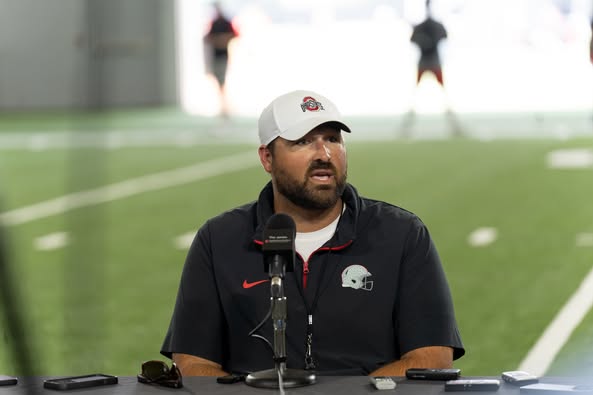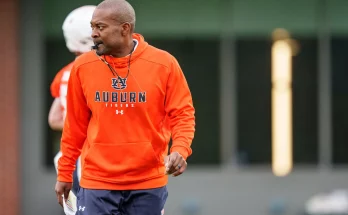Georgia Offensive Line Coach Tyler Bowen Emphasizes Competition and Versatility After Fall Camp Practice
Following the first week of fall camp practice, Georgia’s offensive line group stepped forward to speak with the media, providing a candid and insightful update on the ongoing competition and the importance of versatility within the unit. Offensive line coach Tyler Bowen, known for his strategic approach and player development expertise, addressed the current state of the line, underscoring both the challenges and opportunities that lie ahead as the Bulldogs prepare for the 2025 football season.
Bowen’s remarks highlighted the fluid nature of the offensive line roster as the team navigates through a competitive camp environment. “I don’t want to put a number on it,” Bowen explained when asked about where the unit stands. His measured response reflects the complexity of evaluating a group where multiple players are vying for key positions, and where the coaching staff values depth and adaptability as much as raw talent.
At the heart of Bowen’s message is the concept of competition. The offensive line, often regarded as the foundation of any successful offense, is still very much a work in progress, with several players contending for starting roles. Bowen emphasized that this week of camp would be pivotal in shaping decisions, with a focus on identifying the players who will ultimately take the field. The statement, “This week is going to be a big week,” conveys the urgency and intensity of the situation, as each practice and drill becomes a proving ground for these athletes.
While competition is vital, Bowen also praised the versatility present within the unit. Versatility in an offensive line is highly prized, as it allows coaches to adjust schemes and personnel based on matchups, injuries, and game plan variations. “I feel good about the versatility we have,” Bowen said, acknowledging that the ability of players to fill multiple roles is a significant asset. This adaptability not only increases the depth of the roster but also ensures the Bulldogs can maintain a high level of play even when faced with adversity.
Despite the benefits of versatility, Bowen was clear about the necessity for stability and trust. He noted that at some point, the team must be able to confidently “line up and say, ‘Hey, I can trust the left tackle, I can trust the right tackle and I can trust the right guard.’” This remark speaks to the balance coaches must strike between rotating players to find the best fit and establishing a cohesive, reliable unit. Offensive line positions are highly specialized, and consistency in these roles is crucial for timing, communication, and overall effectiveness.
Bowen’s comments reflect a broader philosophy often seen in successful programs: foster competition to elevate performance but ultimately settle on a consistent lineup that players can depend on. The offensive line’s ability to operate as a unified front directly influences the success of both the running and passing games. Trust among linemen facilitates better communication during plays, quicker recognition of defensive schemes, and more effective execution of blocking assignments.
The coach’s candidness about the ongoing evaluation process also gives insight into the challenges faced during fall camp. Each player brings unique strengths and weaknesses, and the coaching staff must weigh these factors carefully. Injuries, performance under pressure, technique refinement, and mental readiness all play critical roles in determining who will earn starting nods. Bowen’s acknowledgment that the lineup is “ever evolving” suggests that no position is firmly locked in, keeping the competition fierce and players motivated.
In addition to individual evaluations, the offensive line’s chemistry as a unit is a key focus. Offensive line play requires more than individual talent; it demands coordination, communication, and collective effort. Bowen’s emphasis on trust among tackles and guards underscores the need for the unit to function seamlessly, with each player understanding not only their own responsibilities but also how they interact with teammates. This synchronization is vital when facing complex defensive fronts and blitz packages common in high-level college football.
The versatility Bowen references also offers strategic advantages. The ability to slide players between tackle and guard positions or adjust the line’s alignment provides offensive coordinators with more options. This flexibility can confuse opposing defenses, allowing the offense to exploit mismatches and create running lanes or passing windows. Versatile linemen who can perform well at multiple spots become invaluable assets, especially over a long season when injuries and fatigue take their toll.
Bowen’s focus on honing the unit as the season approaches points to the natural progression of fall camp. Early practices often involve experimentation and assessment, while later sessions concentrate on polishing fundamentals and building cohesion. The offensive line’s ability to “start honing in now,” as Bowen put it, will be essential for Georgia to execute its offensive game plan effectively from the season opener.
From a broader perspective, Bowen’s insights offer fans and analysts a window into the preparation and decision-making that underpin Georgia’s offensive line development. The offensive line’s performance is critical in sustaining the Bulldogs’ offensive identity, which blends a powerful running game with efficient passing. As such, the ongoing competition and focus on versatility are not just internal matters but key factors in Georgia’s pursuit of conference and national titles.
Players within the unit have responded positively to the competitive environment. The push to earn starting roles or significant playing time fosters accountability and encourages continuous improvement. Bowen’s comments suggest that while the coaching staff values versatility and adaptability, there is also a clear expectation for players to master specific positions and build reliability. This dual emphasis ensures that the Bulldogs can field a line that is both flexible and dependable.
Looking ahead, the weeks following this initial camp period will be crucial in determining the final offensive line configuration. Coaches will continue to evaluate performances in practice, scrimmages, and possibly early-season games. Bowen’s remarks that “we have to be able to line up and say, ‘Hey, I can trust…’” encapsulate the ultimate goal: a stable and confident offensive line ready to meet the challenges of a demanding season.
The offensive line’s success will have ripple effects throughout the Georgia offense. A strong line creates opportunities for running backs to gain yards after contact, gives quarterbacks the time needed to make accurate throws, and helps maintain possession by minimizing sacks and tackles for loss. The stakes are high, and Bowen’s balanced approach to competition and versatility lays the groundwork for a unit capable of meeting these demands.
In conclusion, Tyler Bowen’s comments following fall camp practice provide a clear and thoughtful perspective on the state of Georgia’s offensive line. The balance between ongoing competition and the need for stability reflects a nuanced understanding of the position group’s critical role. With versatility seen as an asset but trust and consistency as ultimate goals, the Bulldogs’ offensive line is poised to continue its tradition of excellence as it prepares for the 2025 season. As the team moves forward, all eyes will be on this pivotal unit to see how Bowen and his players translate potential into performance on the field.



